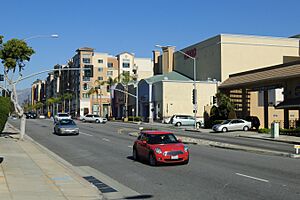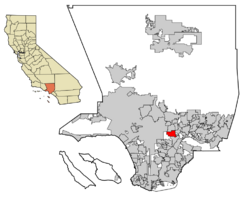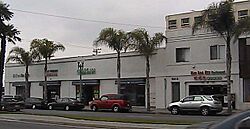Monterey Park, California facts for kids
Quick facts for kids
Monterey Park, California
|
||
|---|---|---|

A busy section of Atlantic Boulevard
|
||
|
||
| Motto(s):
Pride in the Past, Faith in the Future
|
||

Location of Monterey Park in Los Angeles County, California
|
||
| Country | United States | |
| State | California | |
| County | Los Angeles | |
| Incorporated | May 29, 1916 | |
| Government | ||
| • Type | Council-Manager | |
| Area | ||
| • Total | 7.73 sq mi (20.03 km2) | |
| • Land | 7.67 sq mi (19.87 km2) | |
| • Water | 0.06 sq mi (0.16 km2) 0.79% | |
| Elevation | 384 ft (117 m) | |
| Population
(2020)
|
||
| • Total | 61,259 | |
| • Estimate
(2021)
|
59,667 | |
| • Density | 7,776.49/sq mi (3,002.41/km2) | |
| Time zone | UTC-8 (Pacific Time Zone) | |
| • Summer (DST) | UTC-7 (PDT) | |
| ZIP codes |
91754, 91755, 91756
|
|
| Area code | 323, 626 | |
| FIPS code | 06-48914 | |
| GNIS feature IDs | 1652753, 2411146 | |
Monterey Park is a city in Los Angeles County, California, United States. It's about 7 miles (11 km) east of Downtown Los Angeles. The city's motto is "Pride in the past, Faith in the future."
Monterey Park is known for having a large Asian American population. It's often ranked as one of the best places to live in the country. This is because of its good schools, growing economy, and central location.
Contents
History of Monterey Park
Who lived here first?
For thousands of years, the Tongva Native Americans lived on this land. They built dome-shaped homes from natural materials. They wore long hair and had tattoos. When it was warm, they wore light clothing. In cold weather, they wore animal skin capes.
Sadly, when the Spanish arrived, many Tongva people died from new diseases. By the 1870s, very few Native Americans were left.
How did the city grow?
In the early 1800s, the area was part of a large mission system. Later, it became part of a ranch called Rancho San Antonio.
After the American Civil War, a man named Alessandro Repetto bought a large piece of land. He built his ranch house on a hill. Later, in 1886, a banker named Isaias W. Hellman bought part of the land. A street, Hellman Avenue, is named after him.
Richard Garvey, a mail rider, also settled here. He developed the land by bringing in water and building a dam. This created Garvey Lake, where Garvey Ranch Park is now. To pay for his projects, Garvey sold parts of his land.
When did Monterey Park become a city?
In 1906, the first neighborhood, Ramona Acres, was built. In 1916, people living in the area decided to form a city. They did this because nearby cities wanted to build a large sewage plant there. On May 29, 1916, they voted to become a city. The new city leaders quickly banned sewage plants. They named the city Monterey Park, after the oak-covered hills shown on an old map.
In 1920, a part of the city broke away and became the separate city of Montebello.
What happened in the 1920s and beyond?
By 1920, people from Asia began settling in the area. They farmed potatoes and flowers. They also improved the Monterey Pass Trail, which became a road for shipping their produce.
In 1926, near Atlantic Boulevard, Laura Scudder invented the first sealed bag of potato chips! Her team would iron wax paper sheets to make bags. They filled them with chips and sealed them to keep them fresh.
The 1920s were a time of growth for real estate. Many new neighborhoods were planned. One big project was Midwick View Estates, designed to be a fancy community like Bel Air. The main building for this project was "Jardin del Encanto," a beautiful Spanish-style building.
However, the Great Depression in the 1930s stopped this growth. For almost 20 years, not much new development happened.
Growth after World War II
After World War II, Monterey Park grew very quickly. Many veterans moved to the city. New neighborhoods were built, even in areas that were empty before. Japanese Americans, Chinese Americans, and Latinos also started moving to the area. They became part of the city's small-town feel.
Changes from the 1970s to 1990s
Starting in the 1970s, many Asian Americans and immigrants from Asia began moving to Monterey Park. The city council tried to pass laws to make English the only language used on business signs, but these efforts failed.
In the 1980s, Monterey Park was sometimes called "Little Taipei" because many wealthy immigrants from Taiwan moved there. Many businesses from downtown Los Angeles' Chinatown also opened stores in Monterey Park. Mandarin Chinese became a common language in many businesses.
In 1983, Lily Lee Chen became the first Chinese American woman to be elected mayor of a U.S. city. By the late 1980s, immigrants from mainland China and Vietnam also moved in. By 1990, Monterey Park was the first city in the continental U.S. with a majority Asian population.
The large number of new students, including those from Vietnam, Taiwan, and Hong Kong, caused Mark Keppel High School to become very crowded.
In 1988, Monterey Park tried to stop new building projects because of the fast growth. This caused some Asian residents and businesses to move to nearby Alhambra. Later, the city encouraged them to return.
Since the early 1990s, the city's population has continued to change. High property values have also led some people to move out of Monterey Park.
What's new in Monterey Park?
In the 2000s, new projects helped the city grow again. The Atlantic Times Square, which opened in 2010, is a big development with shops, restaurants, a movie theater, and condos. Other shopping centers like Monterey Park Village and Monterey Park Marketplace have also been built.
In 2017, Money magazine named Monterey Park one of "America's Best Places to Live," ranking it #3. It was also ranked #2 for "The 10 Best Places in America to Raise a Family."
Geography of Monterey Park
Monterey Park covers about 7.7 square miles (20 square kilometers). Most of this area is land, with a small amount of water.
The city is next to East Los Angeles to the west, Alhambra to the north, Rosemead to the northeast, and Montebello to the south.
Population and People
| Historical population | |||
|---|---|---|---|
| Census | Pop. | %± | |
| 1920 | 4,108 | — | |
| 1930 | 6,406 | 55.9% | |
| 1940 | 8,531 | 33.2% | |
| 1950 | 20,395 | 139.1% | |
| 1960 | 37,821 | 85.4% | |
| 1970 | 49,166 | 30.0% | |
| 1980 | 54,338 | 10.5% | |
| 1990 | 60,738 | 11.8% | |
| 2000 | 60,051 | −1.1% | |
| 2010 | 60,269 | 0.4% | |
| 2020 | 61,096 | 1.4% | |
| 2021 (est.) | 59,667 | −1.0% | |
| U.S. Decennial Census | |||
Who lives in Monterey Park today?
According to the 2010 United States Census, Monterey Park had a population of 60,269 people.
- About 67% of the people were Asian. Most of these were Chinese (47.7%), but there were also Japanese, Vietnamese, Filipino, Korean, and other Asian groups.
- About 19% of the people were White.
- About 27% of the people were Hispanic or Latino.
The average age in Monterey Park was about 43 years old.
In 2009, Monterey Park had the largest number of people of Chinese descent in the United States. The city has attracted immigrants from Taiwan, mainland China, and overseas Chinese from Southeast Asia. There are also many Japanese, Vietnamese, and Filipino communities in the city.
These were the ten neighborhoods in Los Angeles County with the largest percentage of Asian residents, according to the 2000 census:
- Chinatown, 70.6%
- Monterey Park, 61.1%
- Cerritos, 58.3%
- Walnut, 56.2%
- Rowland Heights, 51.7%
- San Gabriel, 48.9%
- Rosemead, 48.6%
- Alhambra, 47.2%
- San Marino, 46.8%
- Arcadia, 45.4%
Economy and Jobs
The main business area in Monterey Park is called "Downtown Monterey Park." It's near Garfield Avenue and Garvey Avenue. This area has many Chinese businesses, including restaurants with different types of Chinese food. You can find many kinds of food throughout the city.
Where do people work?
Here are some of the biggest employers in Monterey Park:
- East Los Angeles College
- Garfield Medical Center
- Los Angeles County Sheriff's Department
- Superior Court of Los Angeles County - Edmund D. Edelman Children's Court
- City of Monterey Park
- Monterey Park Hospital
- Care1st Health Plan
- Southern California Gas Company
- AT&T
- SynerMed
- Ralphs
- First Data
- California Highway Patrol
- World Journal
- Southern California Edison
- Camino Real Chevrolet
- CVS/pharmacy
Arts and Culture
Monterey Park is home to the Garvey Ranch Observatory. This observatory is run by the Los Angeles Astronomical Society (LAAS). It has an 8-inch telescope, a workshop for making telescopes, and a library with over 1000 books. You can visit the observatory on Wednesday evenings to look at the stars for free.
Jardin El Encanto, also known as "El Encanto," is a Spanish-style building built in 1929. It was originally a sales office for a housing development. It has also been a USO center and a secret bar.
Education in Monterey Park
Colleges and Universities
East Los Angeles College is located in Monterey Park. California State University, Los Angeles is also nearby.
Schools for Kids
Several school districts serve Monterey Park:
- Alhambra Unified School District
- Garvey School District
- Los Angeles Unified School District
- Montebello Unified School District
Public Schools
Alhambra Unified School District
Schools for students from kindergarten to 8th grade include:
- Brightwood School
- Monterey Highlands School
- Repetto School
- Ynez School
Mark Keppel High School serves students from this district and the Garvey School District.
Garvey School District
Two elementary schools in Monterey Park are Hillcrest and Monterey Vista. Monterey Vista is a "Blue Ribbon School," which means it's recognized for being excellent.
Garvey Intermediate School in Rosemead also serves this area.
Los Angeles Unified School District
Robert Hill Lane Elementary School (in Monterey Park), Griffith Middle School, and Garfield High School serve parts of the city.
Montebello Unified School District
Bella Vista Elementary School (in Monterey Park), Macy Intermediate School (in Monterey Park), and Schurr High School (in Montebello) serve this part of the city.
Private Schools
- Saint Stephen Martyr School: This Catholic school opened in 1926 for grades K-8 but closed in 2023.
- Meher Montessori School: Offers preschool, lower, and upper elementary classes.
- St Thomas Aquinas School: A Catholic school for grades K-8, founded in 1963. It is accredited by important educational groups.
- New Avenue School: For Pre-Kindergarten through 8th grade, founded in 1961.
- Alpha-Shen Preschool and Kindergarten
- Esther's Nest Children's School: Pre-Kindergarten—Kindergarten
- Graceland Christian Day Care Center: Pre-Kindergarten—Kindergarten
- Monterey Park Christian School: Pre-Kindergarten—Kindergarten
Public Library
The Monterey Park Bruggemeyer Library serves the city's residents.
Transportation
Monterey Park is connected by major freeways like the Long Beach Freeway (I-710), the San Bernardino Freeway (I-10), and SR 60.
You can get around using public transportation. The city has its own Spirit bus service. There are also buses from Montebello Bus Lines and the Los Angeles County Metropolitan Transportation Authority. The Metro E Line train stops nearby at Atlantic station.
Media
News about Monterey Park is covered by the city's official newspaper, the Cascades Newspaper, and the San Gabriel Valley Tribune.
Famous People from Monterey Park
- Betty Tom Chu - A former mayor of Monterey Park and the first Chinese-American woman lawyer in Southern California.
- Judy Chu - A former mayor of Monterey Park and now a Congresswoman.
- Ernest "Red" Hallen - The official photographer of the Panama Canal.
- Dan Haren - A professional baseball pitcher.
- William Hung - A former American Idol contestant.
- Vania King - A tennis champion who won doubles titles at Wimbledon and the U.S. Open in 2010.
- Saladin McCullough - An NFL player.
- Walter Sarnoi Oupathana - A professional boxer.
- Esther Salas - The first Hispanic woman to be a U.S. District Court judge in New Jersey.
- Roberta Shore - An actress.
- Enrique Torres - A Mexican-American professional wrestler.
- Joyce Alene White Vance - A U.S. Attorney and law professor.
- Michael Woo - A former Los Angeles City Councilman.
- Wilbur Woo - A businessman and leader in the Chinese-American community.
Images for kids
These were the ten neighborhoods in Los Angeles County with the largest percentage of Asian residents, according to the 2000 census:
- Chinatown, 70.6%
- Monterey Park, 61.1%
- Cerritos, 58.3%
- Walnut, 56.2%
- Rowland Heights, 51.7%
- San Gabriel, 48.9%
- Rosemead, 48.6%
- Alhambra, 47.2%
- San Marino, 46.8%
- Arcadia, 45.4%
See also
 In Spanish: Monterey Park (California) para niños
In Spanish: Monterey Park (California) para niños








